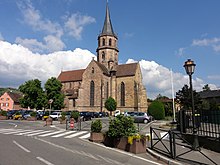St-Maurice (Soultz-Haut-Rhin)
St-Maurice (German: St. Mauritius ) is a Roman Catholic church in the Alsatian municipality of Soultz-Haut-Rhin . It is under monument protection as a monument historique .
history
The first mention of a church in Soultz dates back to 1118. In the 13th century the place received a new building. Of this church, however, only the eastern transept pillars have been preserved. In the 14th century, today's nave, transept and choir were built and finally unified in the 15th century (probably around 1489). In 1491 the church got a one-story crossing tower , which was raised in 1611 by the stonemason Daniel Demaret. During renovation work in the 1970s and 1980s, two niches with paintings from the 14th century and a mural of St. Christopher .
architecture
St-Maurice is a three-aisled basilica . A transept and a choir with a straight end and buttresses at the corners adjoin the nave . Above the crossing there is an octagonal tower with two floors and galleries with openwork stone parapets. In a gusset between the choir and the transept sits a small round tower that only slightly protrudes over the eaves. A wooden structure leads to another stair tower that leads to the crossing tower.
An open vestibule with a round arch and reticulated vault sits on the western gable facade. In this is the main portal of the church. The profiled garment with a pointed arch begins above a high base. In the tympanum you can see the Last Judgment scene . The southern portal with a pointed arch and fine foliage has a two-part tympanum (14th century). In the upper part you can see St. Mauritius on horseback, including the Adoration of the Magi. The northern side portal is similar to that in the south. Its neo-Gothic relief in the tympanum dates from the 20th century and shows the coronation of Mary.
Profiled pointed arch arcades separate the central and side aisles. These rest on bundled services that continue into the upper aisles and there support the ribbed vaults. The nave has four yokes, the fifth yoke then forms the crossing. The choir is vaulted by a yoke. The keystones of the vaults are decorated with the coats of arms of the barons Waldner von Freundstein, as well as several bishops of Strasbourg.
Furnishing
Two ogival wall niches in the nave are painted. A crucifixion scene can be seen on the north side of the transept. The niche in the south transept is divided into two parts. Above you can see a crucifixion, below a dying scene. There are also several Gothic wall paintings from the 14th century in the choir. There is also a Gothic tabernacle with a tall eyelash .
Some of the vaults are also painted: one in blue with gold ornaments, another with the symbols of the four evangelists. Several artistically crafted epitaphs have been preserved, including those of the Commander of the Order of St. John Rudolf von Masmünster (1334), Conrad von Schwalbach (1568), Johann-Heinrich von Schwansbell (1693), Catherine Sitter (1751), Johann-Philipp von Anthès (1760) , Franz-Joseph Immelin (1778) and Franz-Ludwig Waldner von Freundstein (1788). The sacred works of art include a figure of Our Lady (around 1510) and a gilded statue of St. 19th century Mauritius. One of the oldest pieces is a wooden relief depicting St. George killing the dragon. It dates from the 15th century. The church also has a baptismal font from the 16th century. The neo-Gothic baptismal font was created in the 19th century, as were the two side altars. The wooden pulpit and its sound cover were created in the 17th century and were created in the style of the Alsatian Renaissance.
A high altar is missing in the church. Instead, a crucifix and four statues of the evangelists from the 19th century hang on the front wall of the choir.
The organ dates from 1750 and was created by Johann Andreas Silbermann . In the 19th century, Joseph Callinet expanded the organ several times. In 1932 Georg Schwenkedel repaired the instrument. In 1960 it was renewed by Schwenkedel's son Curt. The baroque prospectus was preserved. The organ stands on a wooden gallery, which is supported by two round columns. The instrument has been classified as a Monument historique since 1991.
literature
- Walter Hotz : Handbook of the art monuments in Alsace and Lorraine. Deutscher Kunstverlag, Munich / Berlin 1973, p. 248f
- Dominique Toursel-Harster, Jean-Pierre Beck, Guy Bronner: Alsace. Dictionnaire des monuments historiques. La Nuée Bleue, Strasbourg 1995, p. 423f
Web links
Individual evidence
- ↑ Entry no. PA00085681 in the Base Mérimée of the French Ministry of Culture (French)
- ↑ The organ of St-Maurice ( Memento of the original of March 3, 2016 in the Internet Archive ) Info: The archive link was inserted automatically and has not yet been checked. Please check the original and archive link according to the instructions and then remove this notice. , A la découverte de l'Orgue, Orgues d'Alsace (French), accessed November 29, 2016
Coordinates: 47 ° 53 '13.2 " N , 7 ° 13' 48.3" E



